

|
|
* Le premier film à parler de la " stolen
generation "
Le Film australien " Rabbit proof fence " ("Le chemin de
la liberté" en France) a été réalisé
en 2001 par Phillip Noyce. C'est le premier film à parler de la "
stolen generation " : la génération volée, l'histoire
des 30000 enfants retirés de force à leurs parents par les
autorités australiennes entre 1900 et la fin des années 1960
dans le cadre d'une politique d' " intégration " des aborigènes.
En France, le film est projeté dans les salles à partir du
23 avril 2003, la sortie australienne date de février 2002.
En 1931, Mr Neville, protecteur en chef des Aborigènes pour l'Australie occidentale, présente avec fierté le programme gouvernemental qu'il supervise depuis dix ans : les enfants de sang aborigène sont retirés à leurs familles pour être envoyés dans des institutions où ils sont "préparés à leur nouvelle vie dans la société blanche" comme domestiques ou ouvriers agricoles. A Jigalong, tout près du désert de Gibson, trois jeunes filles aborigènes vivent heureuses auprès de leurs mères : Molly, quatorze ans, sa cousine Gracie, dix ans, et sa soeur Daisy, huit ans. Sur ordre de Mr Neville, le constable Riggs arrache les fillettes à leur famille pour les transférer au camp de Moore River, situé à l'autre bout du continent. Là-bas, les conditions de vie sont sinistres. Les enfants sont entassés dans d'immenses dortoirs, mal soignés, mal nourris... http://www.allocine.com/film/fichefilm_gen_cfilm=28816.html |
||
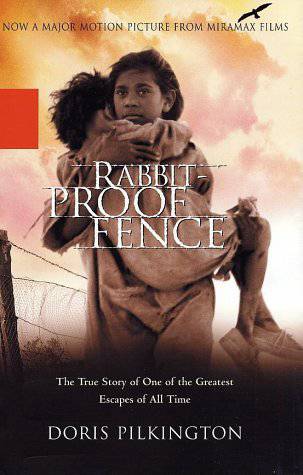 |
Refusant d'accepter la situation, les trois
enfants s'évadèrent et suivirent, pour rejoindre leur
parents au nord de l'Etat, la "rabbit proof fence" (barrière
de protection contre les lapins) qui coupe l'Australie Occidentale en
deux du nord au sud. Gracie fut rattrapée, mais Molly et Daisy
parcoururent plus de 2 400 kilomètres dans l'outback australien.
Doris Pilkington la fille de Molly a relaté cette histoire vraie
dans le livre " Follow the Rabbit-Proof Fence " publié
en 1996. http://www.darkhorizons.com/2002/rabbit/fence-n.htm
Molly et daisy en 2000
|
||||||||||
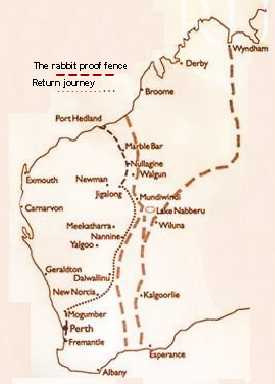 |
||
* En savoir plus sur la génération volée
La page de l' " Australian Human Rights and Equal
Opportunity Commission "
permet de comprendre comment, dans les années 1990, une grande enquête
menée au niveau national a permit de faire le point sur les séparations
d'enfants aborigènes de leur famille. Cette enquête a été
le point de départ du document " bringing them home "
http://www.hreoc.gov.au/social_justice/stolen_children/index.html
la " Reconciliation and Social Justice Library "
de l' " Australasian Legal Information Institute "
permet de télécharger le rapport " bringing them home
"
http://www.austlii.edu.au/au/special/rsjproject/rsjlibrary/hreoc/stolen/
La bilbliotèque du Trinity Collège permet
d'avoir accès à une quantité de liens et de documents
en relation avec la " stolen genration "
http://library.trinity.wa.edu.au/aborigines/stolen.htm
![]() Des cartes sur la répartition des populations aborigènes
avec australie.recherche.fr
Des cartes sur la répartition des populations aborigènes
avec australie.recherche.fr
http://www.univ-lr.fr/international/australie.recherche/page28aactuel/pages28a12345/page28a4b.htm
![]() Une carte sur la répartition des groupes linguistiques
aborigènes avec australie.recherche.fr
Une carte sur la répartition des groupes linguistiques
aborigènes avec australie.recherche.fr
http://www.univ-lr.fr/international/australie.recherche/page28aactuel/pages28a12345/page28a4.htm
* En savoir plus sur la " rabbit proof fence "
Le projet " Run rabbit run " mené en collaboration
entre la " Irwin District Historical Society (IDHS)" de Western
Australia et " Australian Museums and Galleries Online " nous
permet d'en apprendre plus sur la construction de la " rabbit proof
fence "
http://amol.org.au/guide/stories/rabbits/fence.asp
" In 1896, Arthur Gregory Mason reported that rabbits were at least two hundred miles past the South Australian border and inside Western Australia at the town of Eucla. His recommendation to the government was to build a rabbit proof fence.
After much debate and a Royal Commission, the government
eventually adopted the idea of a barrier fence. In 1901 the Government Surveyor,
AW Canning surveyed a route for the fence and its construction began in
December the same year.
…
Even before completion, the rabbits were past the fence and work had begun on Fences No.2 and 3. By 1908 the three fences were complete, over 3,000km of fenceline in total!
Although the construction of the fences was finished,
someone was needed to patrol and maintain them. Alex Crawford was appointed
the first Chief Inspector of Rabbits and was required to inspect and maintain
the fences. Everything inside the fence became known, jokingly, as Crawford's
Paddock. Inspecting the fence was an immense task.
…
In 1910, a motor vehicle was purchased to carry out the inspection, but
was also to prove unsatisfactory. After many punctures and broken springs
it had to be towed slowly back to camp by camels! In the end the only workable
solution for the inspection teams were buckboard buggies pulled by pairs
of camels.
Despite the best efforts to stop the rabbits at the barrier fence, all was to fail. Erosion under the fences, holes in the wire and gates left open allowed rabbits to continue their movement west into the fertile agricultural areas. Ten rabbits could eat as much as one sheep. In their hundreds of thousands they ate out pasture, ring-barked trees and devoured crops."
|
|
|||||
http://www.agric.wa.gov.au/programs/app/barrier/memorabillia/postcards/index.htm |
Le
Department of Agriculture de Western Australia nous explique comment
la clôture a évoluée en " State Barrier Fence of
Western Australia "
http://www.agric.wa.gov.au/programs/app/barrier/SBF_project.htm
" For more than 30 years, the Rabbit Proof Fence helped minimise the movement of rabbits into the agricultural areas of Western Australia. However, in the early 1930s, a new threat to the agricultural area emerged. Drought conditions in the outback sparked an emu migration from the pastoral region to the farming area.
Like rabbits, emus are drawn to the agricultural area by the lure of food from crops and pastures. Such drought conditions prevail about every 10 years, attracting large numbers of emus to the barrier fence.
In 1976, more than 100,000 emus gathered along the northern section of the fence in search of feed, and in 1994 more than 40,000 flocked to the eastern section.
With the decline of the rabbit population in the late 1950s, due to the impact of poisoning and myxomatosis, the fence was modified and realigned to protect agricultural production from the threat of migrating emus. "
 |
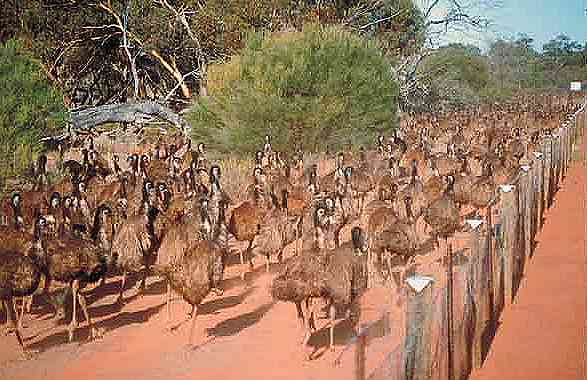 |
|
http://www.agric.wa.gov.au/programs/app/barrier/memorabillia/postcards/index.htm
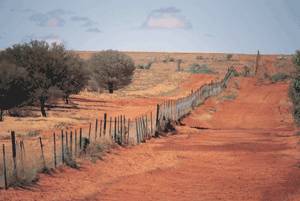
* L'Australian Natural Resources Atlas nous permet de comprendre
comment les lapins sont toujours un problème en Australie.
http://audit.ea.gov.au/ANRA/rangelands/docs/tracking_changes/Track_change_impacts.html
" Rabbits were released in 1859 onto a property
in Victoria for sport and food, and subsequently at a number of other locations.
They have since spread over much of the continent. The rate of spread across
Australia was the fastest known of any colonising mammal in the world.
Rabbits have had a devastating impact on Australia's rangelands. They prevent
regeneration of native plants and compete with livestock and native animals
for available feed. The environmental changes caused by rabbits have contributed
to the decline of many rangeland animal and plant species. Landowners are
legally obliged to control rabbit populations.
The distribution of rabbits reached its greatest extent before the 1950s
for most of the rangelands. The physical environment and control programs
mainly determine their presence and number. The two most well-known and
effective control programs have been the introduction of myxomatosis in
the early 1950s, and the escape and subsequent administering of calicivirus
in the late 1990s. Continued management to further reduce rabbit populations
is essential and would be cost-effective following the control programs.
"
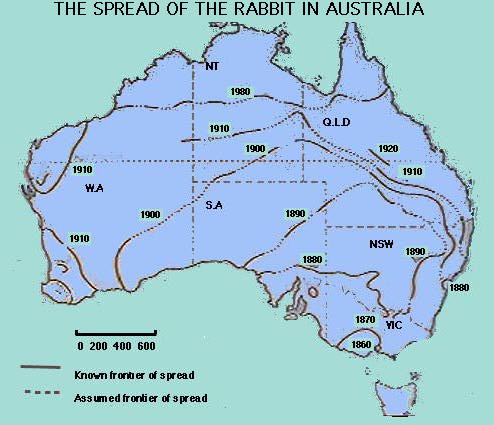 |
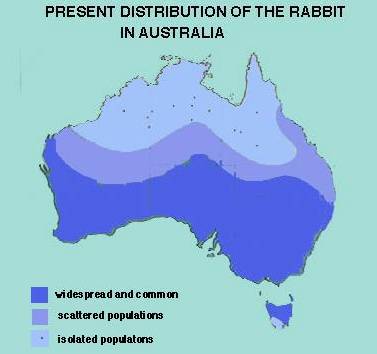 |
|
Ces cartes sur la progression des lapins en Australie et
leur répartition actuelle
sont disponible sur le site
http://rubens.anu.edu.au/student.projects/rabbits/history.html
 |
Le programme Pest Animal Control CRC développé
par le CISRO et différentes universités australiennes
nous montre que le contrôle des populations de lapins est toujours
d'actualité. http://www.pestanimal.crc.org.au/ |
|

* D'autres clôtures existent en Australie
en particulier la " dingo fence "
" A l'origine, elle a été construite
dans les années 1880 pour garder les lapins à l'extérieur
de l'Australie du Sud et du Queensland. Ce fut alors un échec complet,
les dunes, les lits de rivières, les marécages ainsi que les
couches de glaise traversés par la "Dingo Fence", ont rendu
impossible la mission de cette dernière. De toute façon, beaucoup
de ces lapins avait déjà immigrés dans d'autres états,
rendant le travail sur cette "Dingo Fence" totalement inutile.
La "Dingo Fence" était alors appelée à disparaître.
Cependant, depuis 1914, la menace du dingo envahissant les patûrages
des moutons dans le NSW, situés entre le pays des vaches du Queensland
et l'Australie du Sud, devient si sérieuse que quelques ranch furent
forcés de changer leur troupeaux de moutons en troupeaux de vaches.
En effet, le Dingo est trop petit pour s'attaquer aux vaches alors que le
mouton est, pour lui, une proie idéale.
La "Dingo Fence" mesure 5614 Km de Jumbour, dans le Sud-Est du Queensland, jusqu'aux falaises de la "Great Australian Bight " - Grande Morsure Australienne - en Australie de Sud. "
http://www.sky-records.com/francais/pages/recits/281201_barriere_dingos.htm
| Le Department
of Natural Resources and Mines qui gère la " dingo fence
" pour l'Etat du Queensland nous permet de voir la clôture
depuis l'espace. http://www.nrm.qld.gov.au/index.html |
||

En relation avec le sujet
on pourra consulter sur le site "australie.recherche.fr"
la Page Des
cartes sur les aborigènes
la Page Des
cartes sur les aborigènes avec l'Australian Bureau of Statistics
Page préparée par Luc Vacher (mise en ligne février 2003)
|
|